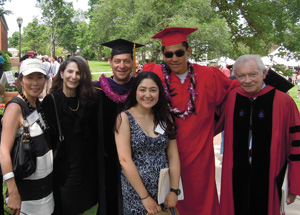As Good As Gold
When members of the Wesleyan Class of ’07 gives their senior gift to alma mater, it will be a donation to financial aid of more than $10,000.
Mary Livingston ’04, assistant director of the Wesleyan Annual Fund for Excellence, is not surprised. “This,” she says, “is the university ethos: the greatest gift is the experience of a Wesleyan education.”
Working closely with the Graduates of the Last Decade (GOLD), she notes that GOLD alumni are most likely to:
1. Live with former Wesleyan roommates
2. Stay in touch with their boxmate
3. Attend grad school or live abroad
4. Move frequently and use a parent’s address as a “home” address
5. Stay in touch with current Wesleyan students
6. E-mail a favorite professor
7. Contact the CRC for career advice
8. Request transcripts from the registrar
9. Want information about issues that concern students.
Traditionally, they are the ones with the most immediate ties to Wesleyan, yet, with their peripatetic lifestyles, are all too easily lost to alumni mailings. They are the most deeply concerned about campus life, yet least apt to make the financial commitment that illustrates that connection.
Livingston believes the latter fact is changing. Since the senior class gift became more important starting in 1985, she believes that the “habit of giving” has been introduced and will continue. This is increasingly important, she says, as younger alumni become an ever larger percentage of the alumni body.
“Younger alumni don’t realize, at first, that there’s a big difference between what they paid for tuition and what a Wesleyan education actually costs,” Livingston says. “When they realize that the contributions of generations of alumni have made their education possible, they want the opportunity to do the same. These four years here were a wonderful experience and it’s really vivid to them. When I was asking my friend to contribute, at first she said that she didn’t have any money. ?Come on, it’s for Wesleyan; weren’t they great years?’ I reminded her. “All right?. I really did have a great time,’ she told me.”
GOLD parties–the same-time-allacross- the-country gatherings–are another way to reach this group. Livingston attended one last year in San Francisco, with her college friends among about 50 people. Did she know everyone there?
“They say that you might not know everyone on the Wesleyan campus, but you recognize faces. That’s how it was–I recognized everyone there–and it’s really great to realize you can strike up a conversation with any Wesleyan graduate. There’s always that common experience, and that’s especially true with people who graduated within the last decade.”
Livingston has realized how hungry GOLD alumni are for campus information. “What does the campus look like now?” they’ll ask, and when they hear about construction, they want the picture of how it would have affected their daily life on campus, their walk to classes.
They want to hear about debates, concerns, or protests that are part of student life. The Internet and the fact that all new graduates have a Wesleyan e-mail address also keep everyone more easily connected. Livingston and Faraneh Carnegie ’05, assistant director for regional alumni programs and networks, have teamed up to create a newsletter geared to these concerns and focused on younger alumni. Links to the Argus and the CRC will also give this group the connections they are eager to use.
In another effort to jumpstart an enduring Wesleyan connection, beginning this year all alumni who have been out fewer than five years will be invited back for Reunion & Commencement. Wesleyan will no longer wait for the usual five-year cycle to begin the Reunion ritual–the time to come back is when memories are fresh; while friends are on campus; while fewer responsibilities hold them in one place.
“At the 10th Reunion, you see a lot of strollers in the alumni parade,” Livingston says. “The GOLD Group is really about moving from college life to what comes next. We want to ease this transition.”

